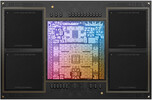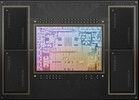Apple M2 Max vs Intel Core 2 Duo T9800 vs Apple M2 Pro 10-Core
Apple M2 Max
► remove from comparison
The Apple M2 Max is a System on a Chip (SoC) from Apple that is found in the early 2023 MacBook Pro 14 and 16-inch models. It offers all 12 CPU cores available in the chip divided in eight performance cores (P-cores) and four power-efficiency cores (E-cores). The E-cores clock with up to 3.4 GHz, the P-Cores up to 3.7 GHz (mostly 3.3 GHz in multi-threaded workloads and 3.4 GHz in single threaded).
The big cores (codename Avalanche) offer 192 KB instruction cache, 128 KB data cache, and 36 MB shared L2 cache (up from 24 MB in the M1 Pro). The four efficiency cores (codename Blizzard) are a lot smaller and offer only 128 KB instruction cache, 64 KB data cache, and 4 MB shared cache. CPU and GPU can both use the 49 MB SLC (System Level Cache).
The unified memory (32, 64, or 96 GB LPDDR5-6400) next to the chip is connected by a 512 Bit memory controller (400 GB/s bandwidth) and can be used by the GPU and CPU.
The CPU performance should be quite similar to the M2 Pro as only the higher memory bandwidth and bigger L3 cache could make a difference for some workloads.
The integrated graphics card in the M1 Max offers a 30-core GPU or a GPU with all 38 cores.
Furthermore, the SoC integrates a fast 16 core neural engine (faster than M1 Max), a secure enclave (e.g., for encryption), a unified memory architecture, Thunderbolt 4 controller, an ISP, and media de- and encoders (including ProRes).
The M2 Max is manufactured in 5 nm at TSMC (second generation) and integrates 40 billion transistors. The power consumption of the CPU part is up to 36 Watt according to powermetrics. When fully loading the CPU and GPU cores, the chip uses up to 89 Watt and the CPU part is limited to 25 Watt.
Intel Core 2 Duo T9800
► remove from comparison
The Intel Core 2 Duo T9800 was the top dual core CPU for laptops at the time of introduction. Later it was topped by the Core 2 Duo T9900 / X9100. Still the T9800 is a high end laptop CPU which is well suited for single and dual threaded applications.
Due to the high clock speed, the T9800 offers enough performance for demanding games (in 2009) and applications. On average, only faster dual cores (like the T9900 or fast Core i7) or Core i7 quad cores can be faster than the T9800.
The T9800 uses a Penryn (Montevina Update) core that features 2 integer units, 1 floating point unit, 1 load unit, and 1 store unit in a 14-stages long pipeline. Due to the Wide Dynamic Execution Technology, the core is able to simultaneously execute up to four instructions.
The integrated Enhanced Speedstep is able to downclock the core dynamically as low as 800 MHz to save power (in idle mode).
The Core 2 Duo T9800 can be used in a Socket P socket with 479 pins: Socket P / Micro Flip-Chip Pin Grid Array (Micro-FCPGA) requires 479-pin surface mount Zero Insertion Force (ZIF) socket (mPGA479M socket) or Micro Flip-Chip Ball Grid Array (Micro-FCBGA) for surface mount (479-ball)
Apple M2 Pro 10-Core
► remove from comparison
The Apple M2 Pro 10-Core is a System on a Chip (SoC) from Apple that is found in the early 2023 MacBook Pro 14 and Mac Mini entry level models. It offers 10 of the 12 cores available in the chip divided in six performance cores (P-cores) and four power-efficiency cores (E-cores). The E-cores clock with up to 3.4 GHz, the P-Cores up to 3.7 GHz (mostly 3.3 GHz in multi-threaded workloads and 3.4 GHz in single threaded).
The big cores (codename Avalanche) offer 192 KB instruction cache, 128 KB data cache, and 36 MB shared L2 cache (up from 24 MB in the M1 Pro). The four efficiency cores (codename Blizzard) are a lot smaller and offer only 128 KB instruction cache, 64 KB data cache, and 4 MB shared cache. CPU and GPU can both use the 24 MB SLC (System Level Cache).
The unified memory (16 or 32 GB LPDDR5-6400) next to the chip is connected by a 256 Bit memory controller (200 GB/s bandwidth) and can be used by the GPU and CPU.
The performance of the M2 Pro 10-Core should be similar to the old M1 Pro with all 10 cores. The multi-threaded performance should be slower, as the M2 10-core has two p-cores less (and 2 e-cores more) but the single-threaded performance should be better due to the faster clock speed and architectural improvements. The old M1 Pro 8-core should be noticeably slower.
The integrated graphics card in the M1 Pro 10-core offers all 16 of the 19 cores.
Furthermore, the SoC integrates a fast 16 core neural engine (faster than M1 Pro), a secure enclave (e.g., for encryption), a unified memory architecture, Thunderbolt 4 controller, an ISP, and media de- and encoders (including ProRes).
The M2 Pro is manufactured in 5 nm at TSMC (second generation) and integrates 40 billion transistors.
| Model | Apple M2 Max | Intel Core 2 Duo T9800 | Apple M2 Pro 10-Core | ||||||||||||||||||||||||||||||||
| Series | Apple M2 | Intel Core 2 Duo | Apple M2 | ||||||||||||||||||||||||||||||||
| Series: M2 |
|
| |||||||||||||||||||||||||||||||||
| Clock | 2424 - 3696 MHz | 2920 MHz | 2424 - 3696 MHz | ||||||||||||||||||||||||||||||||
| L1 Cache | 3.3 MB | 128 KB | 7.3 MB | ||||||||||||||||||||||||||||||||
| L2 Cache | 36 MB | 6 MB | 36 MB | ||||||||||||||||||||||||||||||||
| L3 Cache | 48 MB | 24 MB | |||||||||||||||||||||||||||||||||
| Cores / Threads | 12 / 12 | 2 / 2 | 10 / 10 | ||||||||||||||||||||||||||||||||
| TDP | 79 Watt | 35 Watt | |||||||||||||||||||||||||||||||||
| Transistors | 67000 Million | 410 Million | 40000 Million | ||||||||||||||||||||||||||||||||
| Technology | 5 nm | 45 nm | 5 nm | ||||||||||||||||||||||||||||||||
| Features | ARMv8 Instruction Set | Virtualization (VT-x), Trusted Execution, Intel 64, Enhanced Speedstep, Execute Disable Bit | ARMv8 Instruction Set | ||||||||||||||||||||||||||||||||
| iGPU | Apple M2 Max 38-Core GPU | Apple M2 Pro 16-Core GPU | |||||||||||||||||||||||||||||||||
| Architecture | ARM | x86 | ARM | ||||||||||||||||||||||||||||||||
| Announced | |||||||||||||||||||||||||||||||||||
| Codename | Penryn | ||||||||||||||||||||||||||||||||||
| FSB | 1066 | ||||||||||||||||||||||||||||||||||
| Voltage | 1-1.25 V V | ||||||||||||||||||||||||||||||||||
| Die Size | 107 mm2 | ||||||||||||||||||||||||||||||||||
| max. Temp. | 105 °C | ||||||||||||||||||||||||||||||||||
| Socket | Socket P (BGA479, PGA478) | ||||||||||||||||||||||||||||||||||
| $530 U.S. | |||||||||||||||||||||||||||||||||||
| Manufacturer | ark.intel.com |
Benchmarks
Average Benchmarks Apple M2 Max → 0% n=0
Average Benchmarks Intel Core 2 Duo T9800 → 0% n=0
Average Benchmarks Apple M2 Pro 10-Core → 0% n=0
* Smaller numbers mean a higher performance
1 This benchmark is not used for the average calculation













